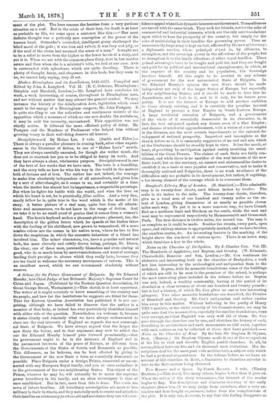aces in the literature of fiction, to one of "
Holme Lee's" novels.
They are always carefully executed, for though she writes much, she does not so overtask her pen as to be obliged to hurry its work. And thoroughly national and Bulgarian, there is no weak avoidance of the both of fortune and of love. The anther has not, indeed, the courage to make him absolutely independent of all antecedents, and gives him by a sort of after-thought, as it seems to us, and certainly at a time a too strong element of the courage which is to overcome them. when the matter has almost lost its importance, a respectable parentage. Stanford's Library Map of London. (E. Stanford.)—This admirable But when he fights his battle with the world, and wine the love on map is in twenty-four sheets, each fifteen inches by twelve. The which his heart is set, he is practicallyfifitis nullius. And a very fine, scale is six inches to the mile. The twenty-four sheets, therefore, manly fellow he is, quite true to the word which is the motto of his give us a total area of one hundred and twenty miles as the ex- dory. A better picture of a real man, quite free from all affects- tent of London, giving dimensions of as nearly as possible eleven Cons and meannesses, we do not know in the range of fiction. And miles each way. To put it in a more concrete way, wo have Croueh we take it to be no small proof of genius that it comes from a woman's End as a northern limit and Mitcham on the south, while the east and band. The hero's boyhood makes a pleasant picture ; pleasant, too, the west may be represented respectively by Hammersmith and Greenwich description of the golden hours which he spends at the Italian lakes Park. The first distance is twelve miles, the second ten. The map is with the darling of his childhood, now grown to womanhood. Of a more as complete as it could be made. Besides the streets, every park, open sombre colour are the scenes he his native town, where he has to live space, and railway-station is appropriately marked, and we have besides, down the suspicions in which the eccentric behaviour of a friend has the omnibus routes, ike. An interesting feature is the marking of the involved him. The minor characters, too, have a genuine and natural height above the sea-level of various spots. There is an index map, leek, the most cleverly and subtly drawn being, perhaps, Mr. Douce, which furnishes a key to the whole.
the vicar, one of those men, personally blameless and even aiming at Notes on the Churches of Derbyshire. By J. Charles Cox. Vol. DI good, who do so much harm by narrowmindedness and want of courage, The Hundreds of Appletree, and Repten, and Greeley. (W. Edmunds, lending their prestige to abuses which they really hate, because they Chesterfield ; Bemrose and Son, London.)—Mr. Cox continues his are too timid to welcome the necessary movements of reform. This is elaborate and interesting book on the churches of Derbyshire, a work an excellent novel, which we can recommend absolutely without not less interesting to the archaeologist and antiquarian than to the
reserve. architect. Repton, with its monastic foundations, some of the buildings


































 Previous page
Previous page